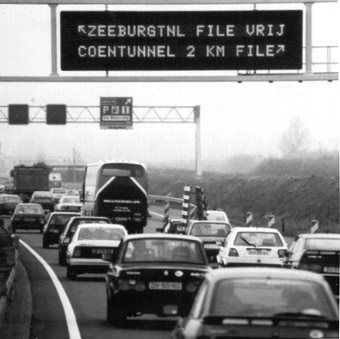
variable message sign on the ringway near Amsterdam

by Henk Nieland

The DYNA project was motivated by the need for traffic control on the European scale, and in particular by the use of telematics to deal with the steady increase of traffic demand and with the limited capacity of the existing motorway network. In the project, a DYNA predictor has been developed, providing estimates of intensities and average speeds in links of the motorway network and predictions of the intensities at network entry points. It also can provide predictions for a horizon up to one hour of intensities and average speeds in links of the network. A DYNA controller will use the predictions of the state variables and produce the input, the variable direction settings. This input is then applied to the real motorway network. CWI was involved in developing the control law underlying the DYNA controller. The other participants in the project were: Hague Consulting Group, CSST (Italy), University of Naples, ELASIS (Italy), Dutch Public Works Department, University of Lancaster, Université Libre Bruxelles, and Delft University of Technology.
In routing control one seeks to influence the route choice of users of a motorway network. It is a form of traffic control and a tool of traffic management. Routing control information is provided by the road operator using public control measures, either in the form of signs near motorway intersections or via radio. Routing control is still in the design phase. A first experiment on the ringway near Amsterdam using a variable message sign indicated that the average travel time decreased by 8%. Early in 1994 the Dutch Public Works Department started similar experiments at several other locations in the Amsterdam area. Routing control is effective because it provides drivers with information on the state of the traffic network such as traffic jams or accidents.
Control measures can take the form of actual information, predictions, and route directives. Most current control measures operate with actual information. Measures providing predictions, for example of travel times, have only been used on a small experimental scale. They are considered with reservation, mainly because of the large uncertainties and the fact that drivers can influence the predictions by their route choice. Therefore attention was focused on the control measure of route directives. These can be provided by radio or by variable message signs on motorways. A traveller on a particular OD (Origin-Destination) pair is thus directed along a route to a region or a motorway exit. As to optimization criteria for routing control one distinguishes user optimality and network optimality. With user optimality every decisionmaker (one for each OD pair or, equivalently, every driver) chooses a route independently of the other decisionmakers. With network optimality the road operator selects routes for all OD pairs. On the advice of the Dutch Public Works Department attention was limited to dynamic user optimality, which corresponds to the formalism of market economics. Control objectives of the flow for a particular OD pair include: travel time, travel distance, travel costs, congestion and stress, and environmental factors.
Routing control is now seen as a dynamic game problem. In formulating a control law, CWI researchers limited attention to a Nash equilibrium (J. Nash, 1951), where for each OD pair the cost - taken as a combination of travel time and travel cost (tolls) - increases when for only that OD pair another control law than the optimal one is used. The control law is synthesized by separately combining the DYNA predictor with a controller based on state feedback. This controller is based on a search for the optimal route within a short time horizon over OD pairs. This control law uses the DYNA predictor and can be realized in practice. The proposed control law needs further investigation, testing by simulation, and testing on the road. It will take several more years of development work before it comes to a road test.
Future research into routing control may concern fast algorithms to compute the route directives by a search procedure over OD pairs, and the properties of a Nash equilibrium.
Please contact:
Jan van Schuppen - CWI
Tel. +31 20 592 4085
E-mail: schuppen![]() cwi.nl
cwi.nl